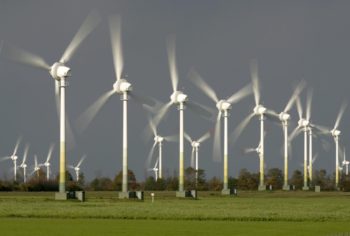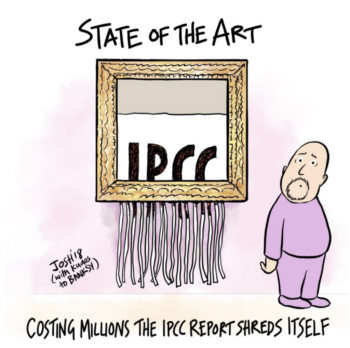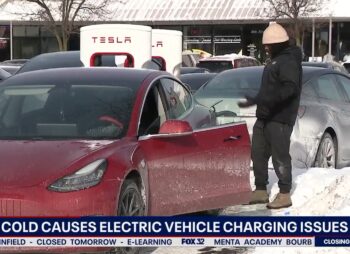
Germany took on that challenge, to show the world how to build a society based entirely on “green, renewable” energy.
It has now hit a brick wall.
Despite huge investments in wind, solar and biofuel energy production capacity, Germany has not reduced CO2 emissions over the last ten years.
However, during the same period, its electricity prices have risen dramatically, significantly impacting factories, employment, and poor families.
Germany has installed solar and wind power to such an extent that it should theoretically be able to satisfy the power requirement on any day that provides sufficient sunshine and wind.
However, since sun and wind are often lacking – in Germany even more so than in other countries like Italy or Greece – the country only manages to produce around 27% of its annual power needs from these sources.
Equally problematical, when solar and wind production are at their maximum, the wind turbines and solar panels often overproduce – that is, they generate more electricity than Germany needs at that time – creating major problems in equalizing production and consumption.
If the electric power system’s frequency is to be kept close to 50Hz (50 cycles per second), it is no longer possible to increase the amount of solar and wind production in Germany without additional, costly measures.
Production is often too high to keep the network frequency stable without disconnecting some solar and wind facilities.
This leads to major energy losses and forced power exports to neighboring countries (“load shedding”) at negative electricity prices, below the cost of generating the power.
In 2017 about half of Germany’s wind-based electricity production was exported. Neighboring countries typically do not want this often unexpected power, and the German power companies must, therefore, pay them to get rid of the excess.
And German customers have to pick up the bill.
If solar and wind power plants are disconnected from the grid in this manner, wind and solar facility owners are paid as if they had produced 90% of the rated output. The bill is also sent to customers.
When wind and solar generation declines and there is insufficient electricity for everyone who needs it, Germany’s utility companies also have to disconnect large power consumers – who then want to be compensated for having to shut down operations.
That bill also goes to customers all over the nation.
Power production from the sun and wind is often quite low and sometimes totally absent. This might take place over periods from one day to ten days, especially during the winter months.
Conventional power plants (coal, natural gas and nuclear) must then step in and deliver according to customer needs.
Hydroelectric and biofuel power can also help, but they are only able to deliver about 10% of the often very high demand, especially if it is really cold.
Alternatively, Germany may import nuclear power from France, oil-fired power from Austria, or coal power from Poland.
In practice, this means Germany can never shut down the conventional power plants, as planned.
These power plants must be ready and able to meet the total power requirements at any time; without them, a stable network frequency is unobtainable. The same is true for French, Austrian and Polish power plants.
Furthermore, if the AC frequency is allowed to drift too high or too low, the risk of extensive blackouts becomes significant.
That was clearly demonstrated by South Australia, which also relies heavily on solar and wind power, and suffered extensive blackouts that shut down factories and cost the state billions of dollars.
The dream of supplying Germany with mainly green energy from sunshine and wind turns out to be nothing but a fading illusion.
Solar and wind power today covers only 27% of electricity consumption and only 5% of Germany’s total energy needs while impairing reliability and raising electricity prices to among the highest in the world.
However, the Germans are not yet planning to end this quest for utopian energy. They want to change the entire energy system and include electricity, heat, and transportation sectors in their plans.
This will require a dramatic increase in electrical energy and much more renewable energy, primarily wind.
To fulfill the German target of getting 60% of their total energy consumption from renewables by 2050, they must multiply the current power production from solar and wind by a factor of 15.
They must also expand their output from conventional power plants by an equal amount, to balance and back up the intermittent renewable energy.
Germany might import some of this balancing power, but even then the scale of this endeavor is enormous.
Perhaps more important, the amount of land, concrete, steel, copper, rare earth metals, lithium, cadmium, hydrocarbon-based composites and other raw materials required to do this is astronomical.
None of those materials is renewable, and none can be extracted, processed and manufactured into wind, solar, or fossil-fueled power plants without fossil fuels. This is simply not sustainable or ecological.
Construction of solar and wind “farms” has already caused massive devastation to Germany’s wildlife habitats, farmlands, ancient forests, and historic villages.
Even today, the northern part of Germany looks like a single enormous wind farm.
Multiplying today’s wind power capacity by a factor 10 or 15 means a 200 meter high (650 foot tall) turbine must be installed every 1.5 km (every mile) across the entire country, within cities, on land, on mountains, and in water.
In reality, it is virtually impossible to increase production by a factor of 15, as promised by the plans.
The cost of Germany’s “Energiewende” (energy transition) is enormous: some 200 billion euros by 2015 – and yet with minimal reduction in CO2 emission.
In fact, coal consumption and CO2 emissions have been stable or risen slightly the last seven to ten years.
In the absence of a miracle, Germany will not be able to fulfill its self-imposed climate commitments, not by 2020, nor by 2030.
What applies to Germany also applies to other countries that now produce their electricity primarily with fossil or nuclear power plants.
To reach development comparable to Germany’s, such countries will be able to replace only about one quarter of their fossil and nuclear power, because these power plants must remain in operation to ensure frequency regulation, balance, and backup power.
Backup power plants will have to run idle (on “spinning reserve”) during periods of high output of renewable energy, while still consuming fuel almost like during normal operation.
They always have to be able to step up to full power, because over the next few hours or days solar or wind power might fail. So they power up and down many times per day and week.
The prospects for reductions in CO2 emissions are thus nearly non-existent!
Indeed, the backup coal or gas plants must operate so inefficiently in this up-and-down mode that they often consume more fuel and emit more (plant-fertilizing) carbon dioxide than if they were simply operating at full power all the time, and there were no wind or solar installations.
There is no indication that the world consumption of coal will decline in the next decades.
Large countries in Asia and Africa continue to build coal-fired power plants, and more than 1,500 coal-fired power plants are in planning or under construction.
This will provide affordable electricity 24/7/365 to 1.3 billion people who still do not have access to electricity today.
Electricity is essential for improved health, living standards and life spans that these people expect and are entitled to.
To tell them fears of climate change are a more pressing matter is a violation of their most basic human rights.
Oddvar Lundseng is a senior engineer with 43 years of experience in the energy business. Hans Konrad Johnsen, Ph.D. is a former R&D manager with Det Norske Oljeselskap ASA. Stein Storlie Bergsmark has a degree in physics and is a former senior energy researcher and former manager of renewable energy education at the University of Agder.

















Germany has experienced defeat three times in one century, 1918, 1945 and 2018.
They’re witnessing the European Union crumble. Four for four?
It’s not that they ran into a wall but into reality that always existed. I am certain that Electric Power Engineers and those who operate the power grids could have told the leaders this. And am sure that some did but were ignored. Now the reality is hitting home. What a shock!
Or more likely fired…..